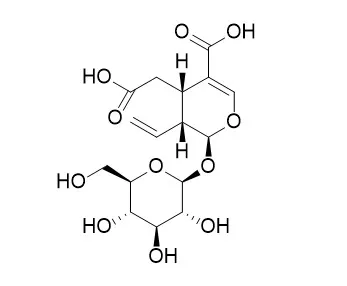| In vitro: |
| Nat Prod Res. 2017 Jun;31(11):1333-1338. | | Biological activities of triterpenoids from Poraqueiba sericea stems.[Pubmed: 27736194 ] |
METHODS AND RESULTS:
Eleven compounds were isolated from Poraqueiba sericea stems and identified as niga-ichigoside-F1 (1), trachelosperoside B1 (2), 4-epi-niga-ichigoside (7), 19α-hydroxyasiatic acid (3), myrianthic acid (4), hyptatic acid (5), trachelosperogenin B (6), arjunolic acid (8), and trachelosperogenin E (9),
Secologanoside (10) and secoxyloganin (11). Compounds 1-11 were tested for their antileishmanial activities against Leishmania infantum promastigotes, 1-6 and 8-11 were tested for their cytotoxic activities on fibroblasts, 1-3, 5-6, 8-11 were evaluated for their anti-elastase and anti-acetylcholinesterase assays activities by a spectrophotometric method and 1-2, 5 and 7-10 were tested using bioautography for their β-glucosidase.
CONCLUSIONS:
No antileishmanial activity was detected; compounds 1, 2 and 11 showed a moderate cytotoxic activity with IC50 17.7, 20.5 and 10.9 μg/mL, respectively; compounds 2, 8, 9 and 10 gave a percentage of inhibition ranging from 13 to 16% (at 50 μg/mL) and compounds 1 and 2 showed an inhibition zone on β-glucosidase and anti-acetylcholinesterase assays. | | Zhongguo Zhong Yao Za Zhi. 2015 Jan;40(2):269-74. | | Anti-complementary phenolic acids from Lonicera japonica.[Pubmed: 26080557] | To study the anti-complementary phenolic acids from Lonicera japonica.
METHODS AND RESULTS:
The anti-complementary activity-directed isolation was carried out with the hemolysis test as guide. All isolation was evaluated for their in vitro anti-complementary activities. The structures were identified by various spectroscopic data including ESI-MS, 1H-NMR, 13C-NMR data.
Fourteen compounds were isolated from the EtOAc fraction of L. japonica extracts, including 8 phenolic acids: 5-O-caffeoylquinic acid (1), chlorogenic (2), 4-O-caffeoylquinic acid (3), 3,5-di-O-caffeoylquinic acid (4), 4,5-di-O-caffeoylquinic acid (5), 3,4-di-O-caffeoylquinic acid (6), caffeic acid (7) and methyl caffeate acid (8); 3 iridoids: Secologanoside (9), sweroside (10) and secoxyloganin (11); and 3 flavonoids: luteolin (12), quercetin (13) and kaempferol (14). Compounds 1-9 and 11-14 showed anti-complementary activity in different extents and 3,5-di-O-caffeoylquinic acid (4) exhibited the most significant activity against the classical pathway.
CONCLUSIONS:
Compound 14 is obtained from this plant for the first time, phenolic acids are the main anti-complementary constituents of L. japonica and 3,5-di-O-caffeoylquinic acid(4) is a potential complement inhibitor with strong activity, which worthy to be studied further in the future. |
|






 Cell. 2018 Jan 11;172(1-2):249-261.e12. doi: 10.1016/j.cell.2017.12.019.IF=36.216(2019)
Cell. 2018 Jan 11;172(1-2):249-261.e12. doi: 10.1016/j.cell.2017.12.019.IF=36.216(2019) Cell Metab. 2020 Mar 3;31(3):534-548.e5. doi: 10.1016/j.cmet.2020.01.002.IF=22.415(2019)
Cell Metab. 2020 Mar 3;31(3):534-548.e5. doi: 10.1016/j.cmet.2020.01.002.IF=22.415(2019) Mol Cell. 2017 Nov 16;68(4):673-685.e6. doi: 10.1016/j.molcel.2017.10.022.IF=14.548(2019)
Mol Cell. 2017 Nov 16;68(4):673-685.e6. doi: 10.1016/j.molcel.2017.10.022.IF=14.548(2019)